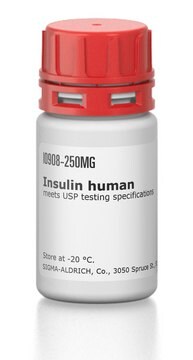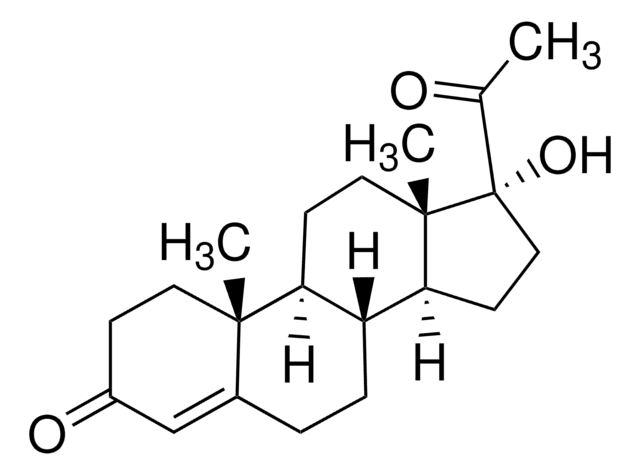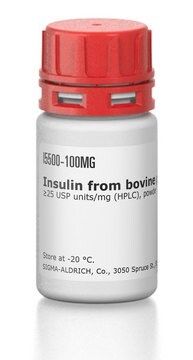I2643
Insulin human
recombinant, expressed in yeast (proprietary host)
Sign Into View Organizational & Contract Pricing
All Photos(3)
About This Item
Empirical Formula (Hill Notation):
C257H383N65O77S6
CAS Number:
Molecular Weight:
5807.57
EC Number:
MDL number:
UNSPSC Code:
12352202
NACRES:
NA.32
biological source:
human
form:
powder
Assay:
≥98% (HPLC)
Recommended Products
biological source
human
Quality Level
recombinant
expressed in yeast (proprietary host)
sterility
non-sterile
Assay
≥98% (HPLC)
form
powder
potency
≥27.5 units/mg (dried basis)
technique(s)
cell culture | mammalian: suitable
solubility
0.01 M HCl: 20 mg/mL, clear, colorless
UniProt accession no.
shipped in
ambient
storage temp.
−20°C
InChI key
PBGKTOXHQIOBKM-FHFVDXKLSA-N
Gene Information
human ... INS(3630)
Looking for similar products? Visit Product Comparison Guide
Application
Insulin human has been used:
- in the culture medium needed for the adipogenesis of ASCs (adipose-derived stem cells)
- to study the effect of insulin in the young and aged brains of rats.
- to study the effect of insulin on the inflammatory actions of protease-activated receptor 2 (PAR2) using mice model.
Biochem/physiol Actions
Two-chain polypeptide hormone produced by the β-cells of pancreatic islets. Its molecular weight is ~5800 Da. The α and β chains are joined by two interchain disulfide bonds. The α chain contains an intrachain disulfide bond. Insulin regulates the cellular uptake, utilization, and storage of glucose, amino acids, and fatty acids and inhibits the breakdown of glycogen, protein, and fat.
Other Notes
InChI: 1S/C257H383N65O77S6/c1-29-131(23)205(313-193(339)104-259)252(393)317-204(130(21)22)248(389)288-159(75-82-200(349)350)217(358)282-156(71-78-189(263)335)221(362)308-183-116-403-404-117-184-243(384)305-178(111-324)240(381)294-162(88-123(7)8)225(366)295-168(95-140-53-61-146(329)62-54-140)228(369)283-154(69-76-187(261)333)218(359)290-161(87-122(5)6)223(364)285-158(74-81-199(347)348)220(361)302-174(101-190(264)336)235(376)298-170(97-142-57-65-148(331)66-58-142)231(372)309-182(242(383)304-176(255(396)397)103-192(266)338)115-402-401-114-181(214(355)273-107-194(340)278-153(72-79-197(343)344)216(357)281-151(51-42-84-271-257(267)268)212(353)272-108-195(341)279-166(93-138-46-36-32-37-47-138)227(368)297-167(94-139-48-38-33-39-49-139)230(371)299-171(98-143-59-67-149(332)68-60-143)238(379)320-208(135(27)327)254(395)322-85-43-52-186(322)246(387)286-152(50-40-41-83-258)222(363)321-209(136(28)328)256(398)399)311-250(391)203(129(19)20)316-236(377)164(90-125(11)12)292-229(370)169(96-141-55-63-147(330)64-56-141)296-224(365)160(86-121(3)4)289-210(351)133(25)277-215(356)157(73-80-198(345)346)287-247(388)202(128(17)18)315-237(378)165(91-126(13)14)293-233(374)173(100-145-106-270-120-276-145)301-239(380)177(110-323)280-196(342)109-274-213(354)180(113-400-405-118-185(310-244(183)385)245(386)319-207(134(26)326)253(394)306-179(112-325)241(382)318-206(132(24)30-2)251(392)312-184)307-226(367)163(89-124(9)10)291-232(373)172(99-144-105-269-119-275-144)300-219(360)155(70-77-188(262)334)284-234(375)175(102-191(265)337)303-249(390)201(127(15)16)314-211(352)150(260)92-137-44-34-31-35-45-137/h31-39,44-49,53-68,105-106,119-136,150-186,201-209,323-332H,29-30,40-43,50-52,69-104,107-118,258-260H2,1-28H3,(H2,261,333)(H2,262,334)(H2,263,335)(H2,264,336)(H2,265,337)(H2,266,338)(H,269,275)(H,270,276)(H,272,353)(H,273,355)(H,274,354)(H,277,356)(H,278,340)(H,279,341)(H,280,342)(H,281,357)(H,282,358)(H,283,369)(H,284,375)(H,285,364)(H,286,387)(H,287,388)(H,288,389)(H,289,351)(H,290,359)(H,291,373)(H,292,370)(H,293,374)(H,294,381)(H,295,366)(H,296,365)(H,297,368)(H,298,376)(H,299,371)(H,300,360)(H,301,380)(H,302,361)(H,303,390)(H,304,383)(H,305,384)(H,306,394)(H,307,367)(H,308,362)(H,309,372)(H,310,385)(H,311,391)(H,312,392)(H,313,339)(H,314,352)(H,315,378)(H,316,377)(H,317,393)(H,318,382)(H,319,386)(H,320,379)(H,321,363)(H,343,344)(H,345,346)(H,347,348)(H,349,350)(H,396,397)(H,398,399)(H4,267,268,271)/t131-,132-,133-,134+,135+,136+,150-,151-,152-,153-,154-,155-,156-,157-,158-,159-,160-,161-,162-,163-,164-,165-,166-,167-,168-,169-,170-,171-,172-,173-,174-,175-,176-,177-,178-,179-,180-,181-,182-,183-,184-,185-,186-,201-,202-,203-,204-,205-,206-,207-,208-,209-/m0/s1
Preparation Note
This product can be solubilized in 20 mg/mL of 0.01 M HCL. After solubilizing the material , a stock solution can be stored for long term storage at -20°C in single-use aliquots. Freeze-thaw cycles should be avoided.
related product
Product No.
Description
Pricing
Storage Class Code
11 - Combustible Solids
WGK
nwg
Flash Point(F)
Not applicable
Flash Point(C)
Not applicable
Personal Protective Equipment
dust mask type N95 (US), Eyeshields, Gloves
Choose from one of the most recent versions:
Already Own This Product?
Find documentation for the products that you have recently purchased in the Document Library.
Customers Also Viewed
Shüné V Oliver et al.
PloS one, 12(7), e0180909-e0180909 (2017-07-13)
Exogenous vertebrate-derived factors circulating in the blood have the capacity to modulate the biology of haematophagous insects. These include insulin, insulin growth factor 1 (IGF) and transforming growth factor β1 (TGFβ). The effects of the consumption of these three proteins
Theresia Gutmann et al.
The Journal of cell biology, 217(5), 1643-1649 (2018-02-18)
Insulin receptor (IR) signaling plays a critical role in the regulation of metabolism and growth in multicellular organisms. IRs are unique among receptor tyrosine kinases in that they exist exclusively as covalent (αβ)2 homodimers at the cell surface. Transmembrane signaling
Linda Adzovic et al.
Journal of neuroinflammation, 12, 63-63 (2015-04-19)
The role of insulin in the brain is still not completely understood. In the periphery, insulin can decrease inflammation induced by lipopolysaccharide (LPS); however, whether insulin can reduce inflammation within the brain is unknown. Experiments administrating intranasal insulin to young
Eric Hyun et al.
Journal of immunology (Baltimore, Md. : 1950), 184(5), 2702-2709 (2010-02-02)
Given the anti-inflammatory effects of insulin in human and animal studies done in vivo and given the signaling pathways in common between insulin and the protease-activated receptor 2 (PAR(2)), a G protein-coupled receptor, we hypothesized that insulin would have an
Armelle Corpet et al.
The EMBO journal, 30(3), 480-493 (2010-12-24)
Mammalian cells possess two isoforms of the histone H3-H4 chaperone anti-silencing function 1 (Asf1), Asf1a and Asf1b. However to date, whether they have individual physiological roles has remained elusive. Here, we aim to elucidate the functional importance of Asf1 isoforms
Our team of scientists has experience in all areas of research including Life Science, Material Science, Chemical Synthesis, Chromatography, Analytical and many others.
Contact Technical Service











